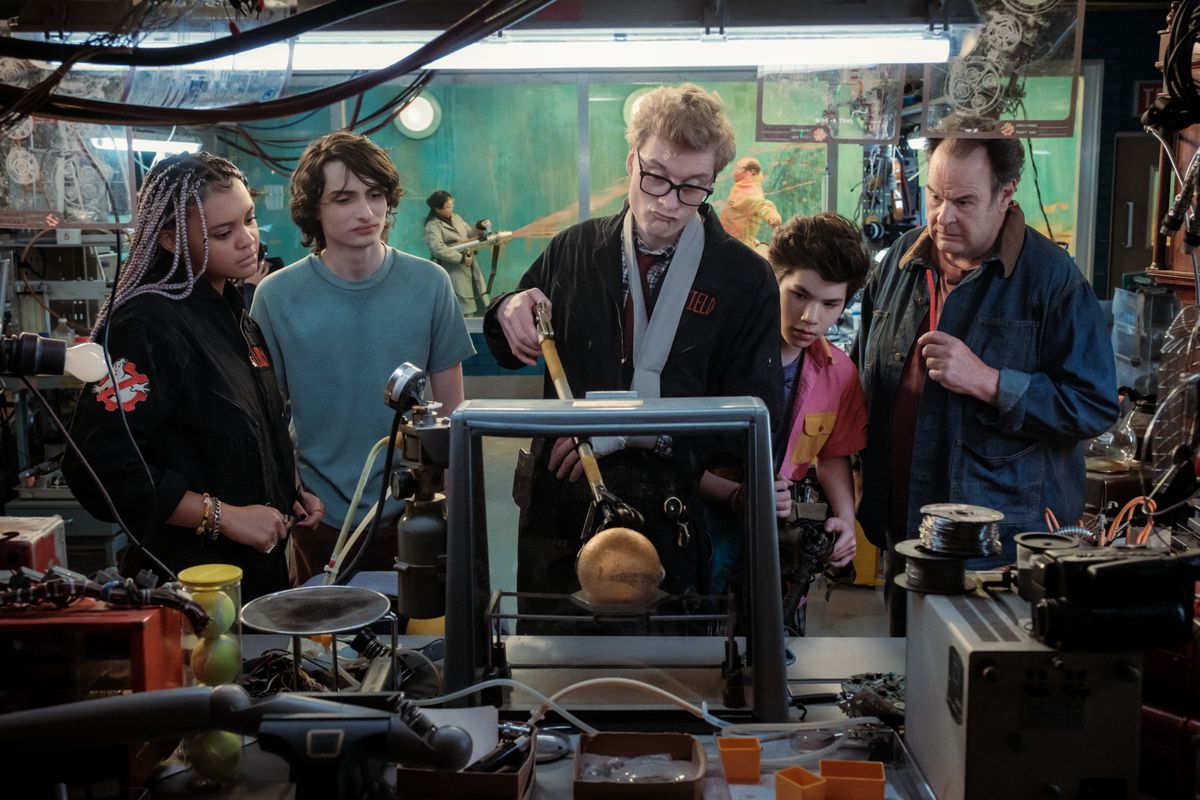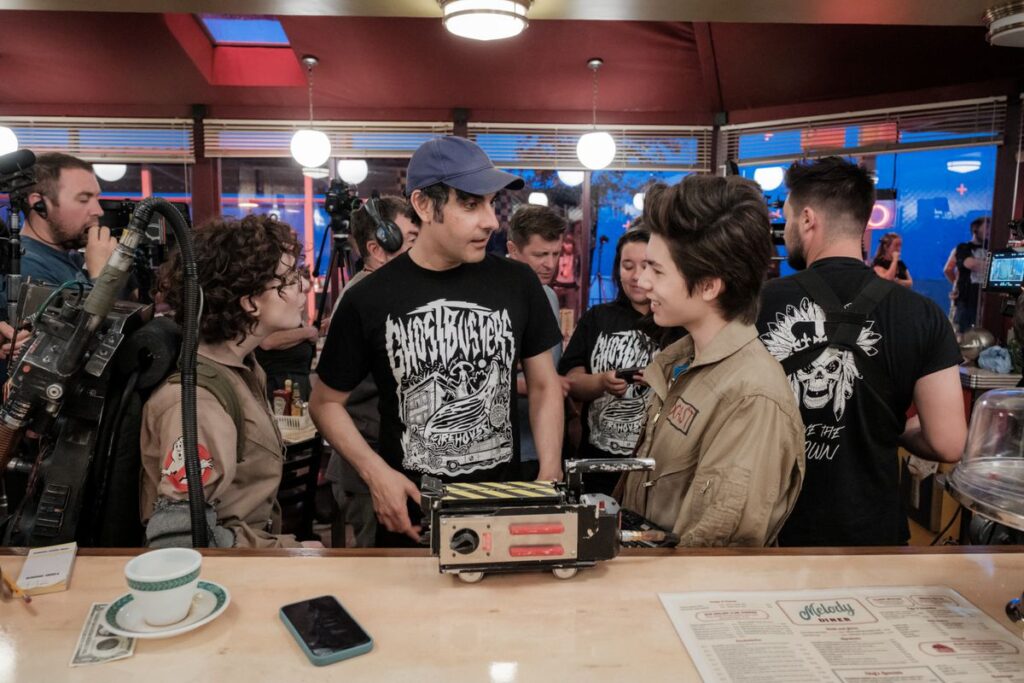For Gil Kenan (Monster House), the chance to co-write Ghostbusters: Afterlife was a dream come true. Directing the sequel was an even taller order — and one he jumped to take. Ghostbusters: Frozen Empire brings the series back to New York, expands the roles of both the legacy Ghostbusters cast and the new additions introduced in Afterlife, and pushes the spectacle level to contend with modern blockbusters.
Die-hard fans of the original Ghostbusters traditionally haven’t taken well to change — see the reactions to Paul Feig’s 2016 reboot of the franchise. But in an interview with Polygon ahead of Frozen Empire’s release, Kenan says his lifelong love of the original 1984 Ghostbusters (and the animated series The Real Ghostbusters) helped him “know what the boundaries are” for rejuvenating the series while respecting Ghostbusters’ essence.
Continuing the story of Ghostbusters: Afterlife, the sequel pairs the living old-timer ’busters (Dan Aykroyd, Bill Murray, Ernie Hudson, Annie Potts) with their next-generation successors, descendants of their old friend Egon Spengler. The new ’busters (Finn Wolfhard, Mckenna Grace, Celeste O’Connor, Logan Kim) get drawn into a bigger adventure this time, facing an ancient evil. By the end, Ghostbusters new and old have to come together to stop yet another angry god.
“The first challenge was writing to their voices,” Kenan says. “And then it was about creating a safe space for each of them to share their gifts with the camera. I love the scenes where we were able to have them all share the screen together and to feel like there was a merging of the new comic sensibilities with the original ones.”
How did Kenan settle on his big choices for Frozen Empire? Where did he find room for Easter eggs? Where could the series go next? We get into it all below.
This interview has been edited and condensed for clarity.
Polygon: How much of the direction you went in with Frozen Empire was related to reactions to Afterlife?
Gil Kenan: We knew when we wrote Afterlife that the next story would come back to New York City, and that the story would need to grow. This is a big city. It’s the opportunity for big stories! So I know that we wanted to have a larger supernatural presence in this new film. That was something we talked about even before we finished Afterlife.
And we were going to be able to make the stakes a lot greater than in Afterlife, because there, we were rekindling a spark that was almost 40 years old. With this story, we’re now able to recontextualize and grow and make a more urgent need for ghostbusting. And so that created an opportunity for new mythology, a new villain, and a threat that was scaled up in a dramatic way.
How do you evolve a franchise like Ghostbusters? The 2016 reboot stirred up a lot of commotion by trying something new.
I think that the only way that I know how to manage the balance is through my own fandom. I’ll speak for myself, but I know that it’s similar for Jason [Reitman, co-writer and director of Ghostbusters: Afterlife], although for him, obviously, it’s colored by the familial connection and responsibility. [Ed. note: Jason’s father, Ivan Reitman, directed the first two Ghostbusters movies.]
But as a fan, I know what I would want to see in a Ghostbusters film. I feel like I intuitively know what the boundaries are. Also, how far I would want the next film to push. And if that proves correct with this film, as it did with Afterlife, then it’ll be confirmation that the way to approach this is organically, from a fan’s point of view, rather than bringing in any sense of an external, artificial- or ego-driven approach to what the expansion would be. I think it’s just it has to be organic, it has to feel like it comes from character and from something that’s truthful to the world of that first film.
Let’s talk about Melody and Phoebe. Mckenna Grace’s character, Phoebe, strikes up an unlikely friendship with the ghost of a young woman who died in a tenement fire, and finds connection — it’s a really sweet relationship. Where did that idea come from, and how did it evolve in the writing process?
As you saw in Afterlife, we develop Phoebe as an extraordinary young person with not just a ferocious intelligence, but also an unusual sensitivity to the supernatural. The relationship Phoebe had with Egon in that film was important personally for her, but also because it suggested that she is open to the abstraction of a communication or relationship with something that is no longer living. That felt like a really fertile ground for storytelling and developing her character.
And we knew we were putting her into an environment where she would be as an adolescent in this family coming to a head with her role, as a Spengler, a Ghostbuster, and a young person moving to a big, scary city at a pivotal age. So the idea of her forging a friendship with a ghost felt like an incredibly interesting path to go down. It was one of our first conversations about this film. We knew that Phoebe was going to come of age, and that she was going to have a friendship with a ghost that was going to change the course of her life.

Photo: Jaap Buitendijk/Sony Pictures
Who was your favorite ghost this time around?
Well, I loved making the Melody scenes, because I believe in ghosts as fully dimensional characters. I always have, as a movie-lover. I believe in ghosts, and I respect them, and I feel like we should be telling more ghost stories in every genre, actually. So those were scenes that were really satisfying for me.
I also I’d be lying if I said that I didn’t enjoy acting like a damn fool every time I was doing a Slimer scene, crawling around on the ground, waving my arms around, chasing Finn Wolfhard around the attic set. Those scenes were a dream come true for me as a Ghostbusters fan.
I can really go on. Pukey is a character I hold near and dear. And of course Garraka, our central villain, who creates such a visceral threat for our heroes. Bringing those climactic scenes to life was me staring down some of the greatest comic actors of our lifetime and using a deep voice and waving my arms around to help to inspire and conjure for them the imagery that one day would be fully realized on screen. I love the sort of storytelling where it’s as big as your imagination.
Do you have any favorite nods to the first Ghostbusters movie here?
I have a tiny one. You might not even notice it. The first time Trevor, Finn’s character, goes up into the attic, when there’s a slime drip in his bedroom, as he’s looking around, scanning the environment, leaned up against the corner of one of the walls is a hand-painted sign that says “Ghostbusters.” It’s the same sign that Ray puts up in the 1984 film before they get their official logo. It’s that kind of thing that makes me so happy, knowing that there is a connection between this firehouse and the story of Ghostbusters of the past.
Are you imagining where a third movie could go? Would you leave New York?
I think that New York is the home of Ghostbusters. We had to fight hard to come back to the city, and I’m really happy we’re back. But it’s a big world out there. I love the idea that there are so many different approaches to the supernatural around the world. Almost every country, every culture, has its own relationship with the unliving. I would be really excited as a fan to see the franchise grow in that direction.

